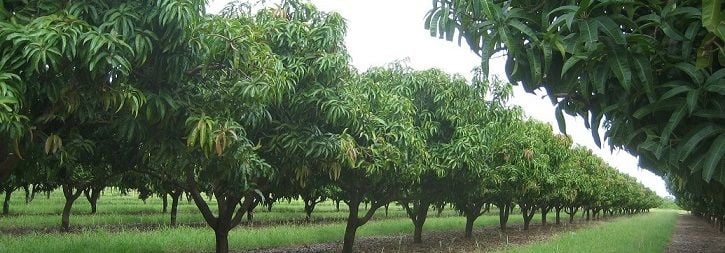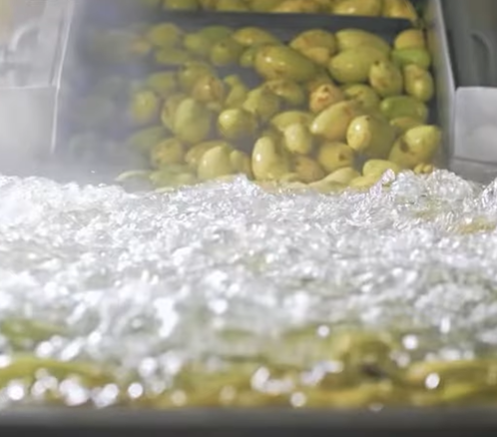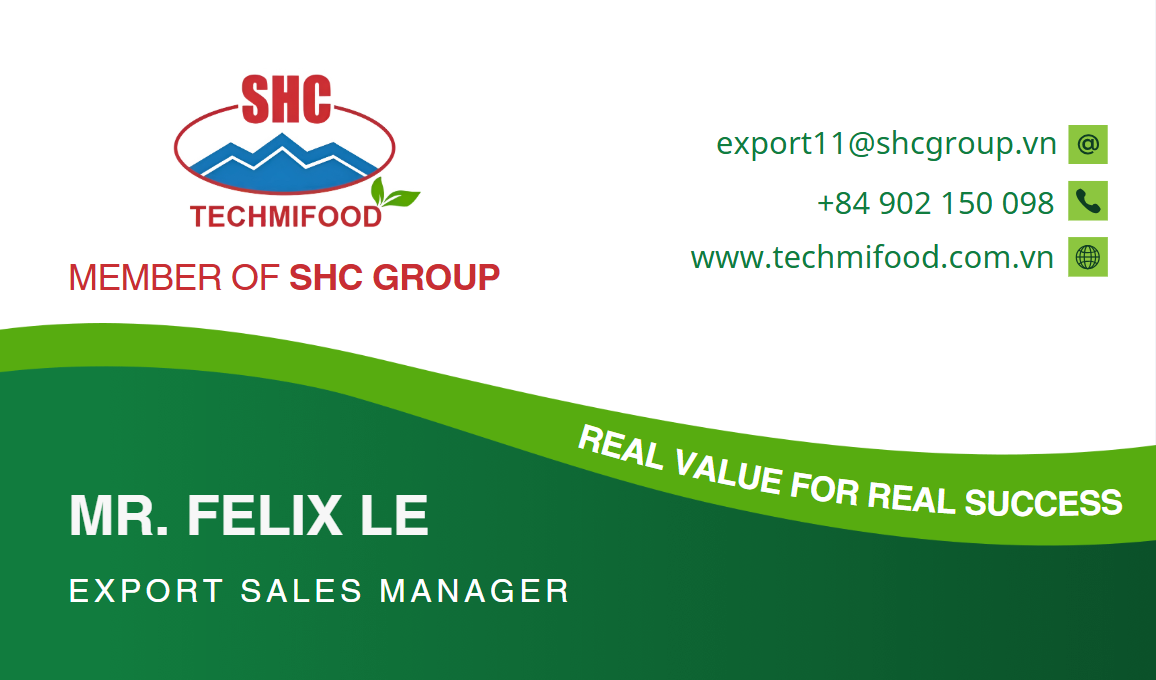Introduction: A Journey of Craft and Flavor
At Techmifood, dried fruit is not just a commodity—it’s a celebration of expertise. Soft dried mango is our pride, made through a deliberate process that respects both nature and science. We call this “The Art of Soft Dried Mango”—a transformation from hearty green orchards to succulent golden slices that offer authentic tropical flavor and premium snacking experience.
1. The Orchard Advantage: Vietnam’s Ideal Mango Terroir
Precision Growing Zones
Techmifood sources its mangoes from three of Vietnam’s most agriculturally rich provinces: Dong Thap, Ben Tre, and Tien Giang. These regions lie in the heart of the Mekong Delta, offering ideal tropical growing conditions characterized by:
-
Alluvial soils, rich in organic matter and minerals, providing natural fertility and optimal drainage.
-
High humidity and sunlight exposure, essential for photosynthesis and sugar development.
-
Stable temperatures ranging from 25–34 °C, ideal for consistent fruit development.
This unique “terroir” yields mangoes with balanced Brix-to-acid ratios, firm pulp, and intense aroma—perfect traits for a high-performance drying application. The terroir contributes to both taste depth and textural integrity, serving as a foundational pillar in our soft dried mango quality.
Varietal Selection Matters
Unlike generic dried mango producers who rely on a single cultivar, Techmifood leverages a multi-variety approach to optimize sweetness, structure, and drying adaptability. Our selection includes:
-
Tommy Atkins: Globally recognized, firm-fleshed, and mildly fibrous, ideal for chewy dried products.
-
Keitt: Larger fruit with vibrant orange pulp and moderate acidity, perfect for balanced flavor.
-
Calcutta: An Indian-origin mango valued for its fragrant aroma and low fiber.
-
Local Cat Hoa Loc: Vietnam’s most prized variety, known for honey-like sweetness and soft texture.
Each variety is chosen for specific properties: high Brix levels (14–18), moderate fiber, and minimal stringiness. Our agronomists work directly with farmers to maintain genetic purity, ensuring consistent characteristics across growing seasons.

Figure 1: Techmifood's mango garden (Techmifood, 2025)
2. Harvesting: Timing for Peak Flavor
Ripeness Thresholds
The flavor integrity of soft dried mango begins at the moment of harvest. Mangoes intended for drying require different timing than those for fresh export. At Techmifood, we harvest when Brix levels hit the 14–18 threshold — the point at which:
-
Natural sugars are at peak development.
-
Acidity moderates, improving sweetness balance.
-
Flesh firmness is ideal for slicing and drying.
We avoid early harvesting (which results in underdeveloped sweetness and flat taste) as well as late picking (which causes excessive softness and microbial risk). Harvesters use manual touch and pressing to gauge fruit softness, complemented by handheld refractometers for random Brix testing.
Gentle Harvesting Techniques
Mangoes are delicate. Improper handling can cause internal bruising, oxidation, or accelerated spoilage. That’s why Techmifood employs manual harvesting using soft-edged blades that reduce stem shock. Harvested fruits are placed in ventilated baskets, avoiding compression damage.
Immediately post-harvest, fruits are cooled to 13–15 °C within 6–8 hours, preserving the:
-
Natural enzymatic structure (important for nutritional retention during drying)
-
Aromatic volatile compounds that give mango its signature fragrance
-
Firm texture needed for clean slicing
This orchard-to-processing pipeline is designed to reduce post-harvest stress, minimize microbial growth, and optimize flavor preservation.

Figure 2: Mangoes are selected carefully by Techmifood's farmers (Techmifood, 2025)
3. Pre-Drying Preparation: Cleaning, Slicing, Sorting
Quality Grading
Upon arrival at Techmifood’s facility, each mango shipment undergoes a multi-point inspection process:
-
Visual grading for skin integrity, coloration, and uniform ripeness
-
Weighing and sizing for batch consistency
-
Internal quality checks, including Brix measurement and pulp examination
Fruits that do not meet our Grade A criteria are diverted to other production streams such as juice extraction or puree manufacturing—ensuring that only top-grade fruit proceeds to the drying line.
Processing for Consistency
Pre-drying processing is engineered for standardization, which is critical for texture and moisture control during drying. Steps include:
-
Washing and brushing to remove dust, latex residue, and surface contaminants.
-
Blanching via brief steam exposure, which serves to:
-
Inactivate enzymes that cause browning
-
Preserve color and texture
-
Enhance microbial safety
-
-
Uniform slicing into 6–8 mm thick strips, optimizing:
-
Drying rate uniformity
-
Final moisture retention
-
Bite experience
-
Advanced stainless steel slicers calibrated to tight tolerances ensure minimal edge shredding and optimal surface exposure, laying the groundwork for consistent drying outcomes.

Figure 3: The fresh mangoes are being washed in the factory of Techmifood (Techmifood, 2025)
4. The Soft Drying Technique: Science Meets Art
In the global fruit export market, soft dried mango is more than a snack — it's a high-demand ingredient for health-conscious consumers, retailers, and manufacturers alike. But consistency, texture, and shelf stability remain major barriers for many suppliers. At Techmifood, we've addressed this challenge through a drying process that’s both scientifically engineered and artfully executed.
Low-Heat Precision Drying
Unlike conventional high-heat dehydration, which often leads to sugar crystallization and nutrient loss, Techmifood uses a proprietary low-temperature method (max 60°C). Drying over 8–14 hours, our system preserves the mango’s natural color, fiber structure, and volatile aroma compounds — critical for premium positioning in overseas markets.
Intelligent Humidity Management
Moisture control is key to texture. We aim for an 18–22% final moisture content without additives. Our drying chambers use humidity sensors and dewpoint control to avoid surface hardening and ensure uniform softness across every batch — making our mango ideal for clean-label branding and private label use.
Engineered Airflow, Layered Racks
With multi-tiered mesh racks and directed airflow, we achieve consistent dehydration across all trays. This technical setup guarantees export-ready uniformity — a non-negotiable standard in B2B procurement.

Figure 4: The mangoes are being ready to be dried (Techmifood, 2025)
5. Food Safety & Traceability: Built for Global Supply Chains
The Result?
A soft dried mango that’s shelf-stable, chewable, naturally sweet — and compliant with global standards (HACCP, ISO, FDA). Whether you’re sourcing for retail chains, foodservice, or contract manufacturing, Techmifood delivers a product that performs and sells.
Manufacturing sites are certified under HACCP, ISO 22000, GlobalGAP, and FDA (USA). Regular audits ensure full compliance.
End-to-End Traceability
Each batch is tracked from GPS farm to final packaging. Data includes harvest date, drying logs, moisture tests, and COA availability on demand.

6. Packaging & Market Readiness
-
Retail packs: 100, 200, 250, or 500 g resealable pouches with tamper-evident closure
-
Bulk formats: 10-20kg carton
-
Private-label ready: Custom formats, artwork, and certifications
Compliant with EU, US, Japan, and ASEAN market labeling requirements. We provide multilingual packaging, COA, MSDS, and more.
7. The Commercial Edge: Why Techmifood Stands Out?
| Feature | Techmifood Mango | Conventional Dried Mango |
|---|---|---|
| Sweetness (Brix) | 14–18 | Typically 12–15 |
| Texture | Soft & chewy | Often dry & brittle |
| Shelf-life | 12 months (airtight) | Variable, shorter |
| Ingredients | Mango + cane sugar only | Sulfites, preservatives |
| Traceability | GPS logged | Vague or absent |
| Social Impact | Smallholder support | Industrial/large farms |
Table: Why Techmifood Stands Out?
Conclusion: A Flavorful Legacy
“The Art of Soft Dried Mango: From Orchard to Optimal Flavor” is not just a title—it’s a statement of purpose. Techmifood’s soft dried mango is the product of sustainable sourcing, farmer upliftment, food science, and artisanal attention.
This is a product with a story—a snack that brings global consumers a genuine, ethical, and premium experience.
Ready to elevate your offering?












